Health in the Loft; Your’s, Not the Pigeons.
The subject of this article is your health and how to keep it.

You will hear the condition of interest called many things including Pigeon Fanciers’ Lung (PFL), Pigeon Breeders’ Lung (PBL), Bird Fanciers Lung (BFL) and Bird Breeders’ Lung (BBL), Pigeon Breeders’ Disease (PBD). PFL is the most accurate when dealing exclusively with pigeons. PBL implies that only breeders are affected, which is clearly not the case. Many pigeon fanciers have indicated that they experience typical symptoms in circumstances such as shows, an activity that has nothing to do with breeding 1.
PFL is a form of Extrinsic Allergic Alveolitis (EAA). The Americans call it Hypersensitivity Pneumonitis. EAA also affects people who keep other types of birds, particularly budgerigars in the house. Another form of EAA is “Farmers Lung”.
SYMPTOMS:
There are two distinct but overlapping phases of EAA, “acute” and “chronic”.
The acute phase is the most common in pigeon fanciers. Typically sufferers experience intense flu-like symptoms of fever, chills, muscle ache, cough and/or breathlessness four to eight hours after high level exposure to pigeons such as occurs when cleaning the loft or basketing pigeons. A medical practitioner may be able to detect lung abnormalities using a stethoscope and X-rays. Blood tests may reveal high levels of antibodies to pigeon proteins. The symptoms usually pass within 48 hours but may persist for a week or more. Although the attack itself will probably pass without treatment it is important to visit the doctor whilst symptoms are still present, preferably on the day of onset, as if you delay there may be no symptoms for the doctor to discover. It is important that sufferers are identified as early as possible to prevent progression to the more serious chronic stage of PFL. If detected and appropriate measures taken early enough, acute PFL is reversible.
Make sure you inform the doctor that you keep pigeons and exactly how long passed between exposure to pigeons and the onset of symptoms.
If not detected or ignored the acute phase may be followed by the chronic phase which is characterised by a type of irreversible lung damage the doctors call “pulmonary fibrosis”. This is very serious and in extreme cases may be fatal. The major symptoms detectable by the layman are breathlessness on exertion, cough and weight loss, which can be considerable.
If you think you might be affected do not panic. Seek medical advice. The doctor should order a number of tests to determine what the problem is. Remember that there are many other possible causes for your symptoms besides your pigeons. Make sure that your doctor has considered the alternatives as well. Do not be afraid to ask for a second opinion.
CAUSES:
It was not until 1965 that Pigeon Fanciers’ Lung was first described in the scientific literature 2. Since then considerable research has been done into this and other forms of “Bird-Breeders’ Lung” and new material continues to be published.
There are several schools of thought in the scientific community about the precise disease mechanisms. None of them have been conclusively proved. There is however general agreement that pigeon fanciers are a high risk group and that inhaling pigeon materials causes PFL to develop in some susceptible individuals. Other fanciers with similar exposure to pigeons do not develop the disease. There is no reliable method to predict who will be affected and who will not. Hopefully the scientists will eventually develop a reliable method but so far they have not. Until they do everyone exposed to pigeons should consider themselves at risk and take precautions to minimise the amount of pigeon materials they breathe in.
Exactly which pigeon materials cause the disease has not yet been proved. The leading contenders are droppings and feather bloom, but whatever the cause, the most important characteristic is that the particles must be small enough for a high proportion of them to reach and be deposited in the gas exchanging region of the lungs. For this to happen they must be less than 5 microns in diameter. A micron is one thousandth of a millimetre. For practical purposes this means that the particles with the potential to cause problems cannot be seen with the naked eye. Bloom particle size has been measured at approximately 1 micron 3.
Every flyer has his or her own management methods. This paper cannot discuss them all. As you read this guideline consider what you do that puts you in a position where you may be breathing in pigeon materials.
COMMON RISK SITUATIONS:
Loft Cleaning: Do not allow droppings to build up. Remember that it is the particles you can’t see that are the most dangerous. The best way to remove dust is with a vacuum cleaner. It may be necessary to fit a filter over the cleaner’s air exhaust to prevent dust simply passing through the machine and being pumped back into the loft. Wash the inside of the loft out periodically with a hose (after removing the birds). Do this first thing in the morning on a fine day so that it has time to dry. Don’t forget the stock loft.
Handling Pigeons: Anyone who has handled pigeons, particularly racing homers, is familiar with what Colin Osman 4 calls “the dust which soils waistcoats”. This is particularly noticeable on race basketing days at the club when birds have been individually examined at home and then again at the club. This material on clothing and hands is readily transferred to the breathing zone and then inhaled. See the section on protective clothing.
Releasing Birds for Exercise: Each downbeat of a bird’s wings creates a powerful downdraught of air, consequently spreading dust. A recently published study 5 has found that when the flock is liberated for exercise the combined beating of all those wings as they leave their perches and strain for altitude stirs up any dust in the loft and it does not return to normal levels for ten to fifteen minutes.
The implications of this finding are that you should:
leave the immediate area of the loft as soon as you release the birds, not return until the dust has settled, wear a mask if you have to go into the loft for any reason in this period.
Feather Sheath Particles:
In breeding lofts where fast growing youngsters are located, and in all lofts during the annual moult, feather sheath particles occur in large quantities significantly increasing the amount of material in the loft environment.
Transport of Pigeons:
Inhalation of pigeon materials must be avoided wherever they occur. However, many flyers who keep their lofts scrupulously clean will sit in a closed car for hours with dozens of pigeons when going for a toss.
In an ideal world we would all have special vehicles for our pigeons. A utility where the humans and pigeons ride in completely separate compartments of the vehicle is ideal. However in the real world most of us have to make do with the same vehicle we use every day. Nevertheless there are steps which can be taken to minimise exposure when tossing:
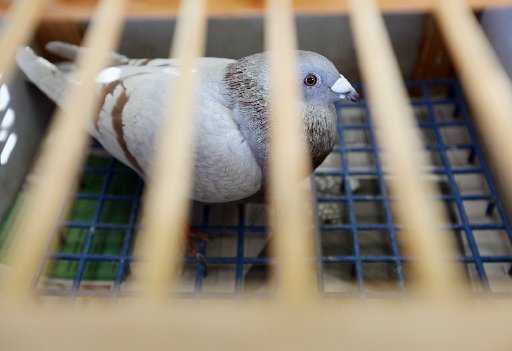 Keep crates clean. Do not allow dust and feathers to build up. Periodically wash them out with water. Put the birds in the car just before you leave and remove the empty crates from the car as soon as you return home. Keep to an absolute minimum the time that birds are in the car. When birds are in the car maximise ventilation. Arrange airflow to carry pigeon materials away from your breathing zone. The best way to achieve this will depend on your vehicle. As a guide the following has been found to work well in the author’s station wagon when carrying just the driver and birds. The driver’s side windows are closed and both passenger’s side windows partly opened. Dashboard air vents, which draw fresh air directly from outside the vehicle are aimed into the driver’s breathing zone and the fan turned to its highest setting. Do not allow dust to build up. Vacuum the vehicle interior immediately following the transportation of birds. Use low dust fillings in the crates (see “Loft Litter” below). Individuals who have had previous acute attacks of PFL it may find it necessary wear a mask when transporting pigeons in their car.
Keep crates clean. Do not allow dust and feathers to build up. Periodically wash them out with water. Put the birds in the car just before you leave and remove the empty crates from the car as soon as you return home. Keep to an absolute minimum the time that birds are in the car. When birds are in the car maximise ventilation. Arrange airflow to carry pigeon materials away from your breathing zone. The best way to achieve this will depend on your vehicle. As a guide the following has been found to work well in the author’s station wagon when carrying just the driver and birds. The driver’s side windows are closed and both passenger’s side windows partly opened. Dashboard air vents, which draw fresh air directly from outside the vehicle are aimed into the driver’s breathing zone and the fan turned to its highest setting. Do not allow dust to build up. Vacuum the vehicle interior immediately following the transportation of birds. Use low dust fillings in the crates (see “Loft Litter” below). Individuals who have had previous acute attacks of PFL it may find it necessary wear a mask when transporting pigeons in their car.
Loft Litter:
The same recently published study referred to above 5 found that lofts using the deep litter method had significantly higher levels of pigeon materials than lofts cleaned regularly (usually daily). Litters used in the studied lofts included hay, woodchips, sawdust or sand to which lime may have been added. Further testing was done in a purpose built experimental loft using sand, sand and lime, woodchips, woodchips and lime, hay and sepolite. Highest counts were observed for sepolite, lowest for wood/lime as litters.
Other Hazards:
Be aware that other materials in the loft environment can also cause respiratory problems. Nesting material, shavings and grain dust to name just a few can cause problems just as serious as pigeon materials and need to be controlled or protected against.
HOW TO MINIMISE YOUR EXPOSURE:
Loft Design: Health and Safety professionals employ personal protective equipment to prevent ill health only as a last resort. Before resorting to respiratory protection devices you should consider if you can adopt “engineering” solutions to solve the problem. Designing lofts to minimise the amount of pigeon materials in the fancier’s breathing zone should be the first strategy employed to minimise the problem.
Many flyers spend a great deal of time and money devising means of improving airflow for the birds. Unfortunately, the classical solution as to what is good for the pigeons, stale air being vented at ceiling level, fresh air being introduced at floor level, is probably not that good for the flyer. The air is drawn in past the droppings, past the birds, through the flier’s breathing zone, and then expelled from the loft. Ideally the fresh air should pass through the flier’s breathing zone before coming into contact with any pigeon materials, including of course the birds themselves. Some form of artificial direction of airflow would be necessary to achieve this. Fresh air, if necessary drawn through ducting from ground level, would have to be forced into the loft at ceiling level by mechanical means. Stale air should be extracted from the loft, taking as much dust as possible with it, at ground level. These exhaust vents should not be located anywhere near the intake vents.
The ease of implementing this will vary according the nature of your loft and the depth of your pocket. In warm climates where lofts usually have at least one wall that consists mostly of wire mesh or dowelling, ventilation engineering is difficult (but not impossible). In colder climates where the loft is frequently entirely enclosed ventilation control is much easier.
Self cleaning systems are now in use in some lofts. They range in sophistication (and price) from elaborate automatic machinery to the now increasingly common wire floored loft. The author is not aware of any research done in this area but they appear attractive both from the health viewpoint as well as a significant time saving device. You need to remember that any system is only as good as its maintenance. The droppings etc. eventually wind up somewhere however they are removed from the loft. Make sure that you are not just shifting the problem from one area to another instead of solving it.
Lofts should be designed so that there are no areas where dust can become trapped and build up. In particular ensure that perches are not fitted flush to the wall. Leave sufficient space so that any pigeon materials deposited at the rear of the perch can drop to the floor.
Personal Protective Equipment:
 Respiratory Protection (Masks): A small scale study (six subjects) published in 1981 6 indicated that respirators “can offer substantial, and in most cases, complete protection against single exposures to environmental dusts that may provoke EAA.” This study is encouraging but needs to be verified and extended by a larger scale study.
Respiratory Protection (Masks): A small scale study (six subjects) published in 1981 6 indicated that respirators “can offer substantial, and in most cases, complete protection against single exposures to environmental dusts that may provoke EAA.” This study is encouraging but needs to be verified and extended by a larger scale study.
Masks come in a variety of shapes, sizes and types. It is vital that you get the correct type and that it fits you exactly. Even small leaks around a mask can result in exposure . For this reason the masks need to fit snugly. There is no point in wearing an ill fitting mask. Masks are designed to protect the wearer from specific hazards. Ensure that the one selected for use with pigeons is designed to protect the wearer against “dust”. A mask designed to protect against other hazards will not protect against the inhalation of pigeon materials.
Unfortunately there are a number of sub-standard devices on the market which look good but do not offer adequate protection. The best way of checking that you have the correct type is to ensure that the mask chosen is designed for protection against “dust” as defined in Australian /New Zealand Standard 1715-1994 7 or international equivalent (Editors note: As this document will be viewed world wide, we cannot provide the equivalent standard for each country. To be safe please follow Mr. Gleeson’s advice. The safety supply dealer who sells you the mask should be able to provide the appropriate information)
Storage of respirators is important. They must be kept in a location where there is no possibility of them being contaminated. A large dose of contaminant can be inhaled if the inside of the mask is unclean. It is pointless to wear a mask as protection from materials that are inside the mask.
Beards and moustaches can create difficulties in achieving a proper fit. If you have one it may be necessary to wear a different type of device. Under these circumstances it is advisable to go to a reputable supplier of industrial safety equipment and be personally fitted.
Masks however have the disadvantage of being uncomfortable and of not being worn. Even with the best intentions it is difficult to remember to put the mask on every time the loft is visited. This is especially true if it is intended to be there for a few minutes to attend to a particular chore, or as frequently happens, one just arrives at the loft with no conscious forethought. Thus, whilst it is relatively simple to protect yourself with a mask when you know in advance that you will be exposed to large doses of antigen (e.g. during cleaning) this is not a viable long term strategy for protection against small but frequent exposures if it is not worn on each and every occasion.
Protective Clothing:
 Family members can be at risk from pigeon materials brought into the house on flyers’ clothing. There are recorded instances in the scientific literature of a flier’s wife contracting PFL even though she had nothing to do with the pigeons 8. The most likely explanation is that be contamination by pigeon materials brought into the house on the flier’s clothing is sufficient to affect another person exposed to the clothing.
Family members can be at risk from pigeon materials brought into the house on flyers’ clothing. There are recorded instances in the scientific literature of a flier’s wife contracting PFL even though she had nothing to do with the pigeons 8. The most likely explanation is that be contamination by pigeon materials brought into the house on the flier’s clothing is sufficient to affect another person exposed to the clothing.
The answer to this to wear an extra layer of protective clothing (overalls or a dust coat) when in the loft or handling pigeons and remove the clothing before entering the house. The contaminated clothes should be placed in a sealed container when not in use. Special easily removed footwear should also be used to visit the loft (e.g. a pair of thongs left outside the back door of the house.
The only time this protective clothing is taken into the house should be for washing. It should be taken direct to the laundry and washed immediately. Do not allow it to contaminate other clothing.
Personal Hygiene:
Pigeon materials also build up on the skin. You should wash your hands with soap and water after handling birds and shower after cleaning the loft.
Pigeon Behaviour:
The activities of the birds themselves can be a problem as they fly about inside the loft. Each downbeat of a bird’s wings creates a powerful downdraught of air, consequently spreading dust. Lofts should be designed so that as far as possible pigeons must walk rather than fly when moving about internally and cannot escape when you wish to catch them. Training pigeons to accept your presence in the loft can also substantially reduce this flying about. A bonus is that you will find that this training has a positive effect on their racing performance.
The flock instinct makes wild behaviour spread rapidly through the loft. The occasional idiot that flies madly about whenever you enter the loft should be eliminated.
Frequent Baths:
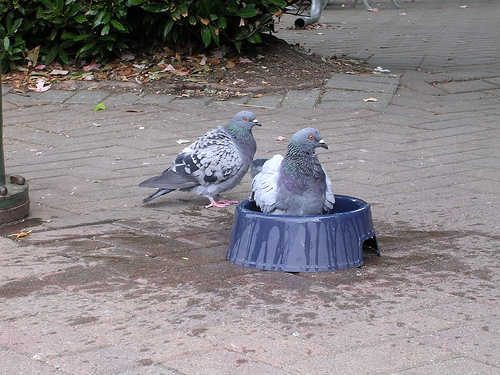 Provide baths as frequently as possible, preferably outside of the loft. This can substantially reduce the amount of atmospheric bloom in the loft. You cannot give the birds too many baths. They will regulate this themselves. There is one exception to this rule. Birds should not be permitted to bathe within three days of racing as they will not have sufficient wax in their wings to protect them should it rain.
Provide baths as frequently as possible, preferably outside of the loft. This can substantially reduce the amount of atmospheric bloom in the loft. You cannot give the birds too many baths. They will regulate this themselves. There is one exception to this rule. Birds should not be permitted to bathe within three days of racing as they will not have sufficient wax in their wings to protect them should it rain.
Health in the Loft; Your’s, Not the Pigeons. by: Gary Gleeson
The Leading Online Pigeon Racing and Racing Pigeons Magazine – The Pigeon Insider

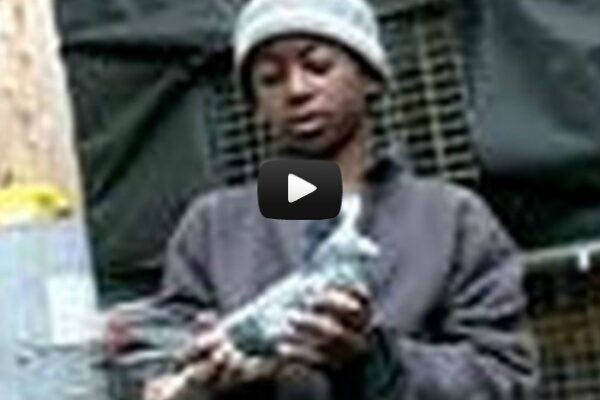
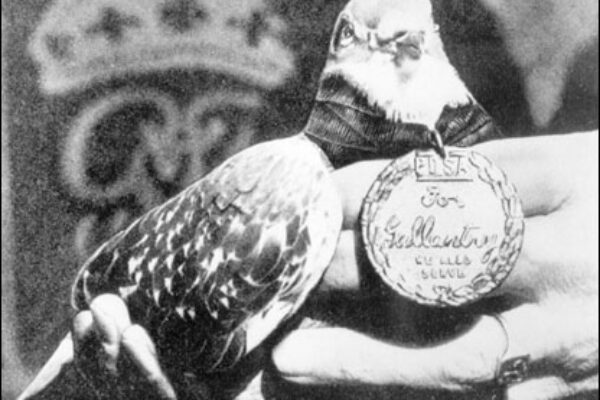
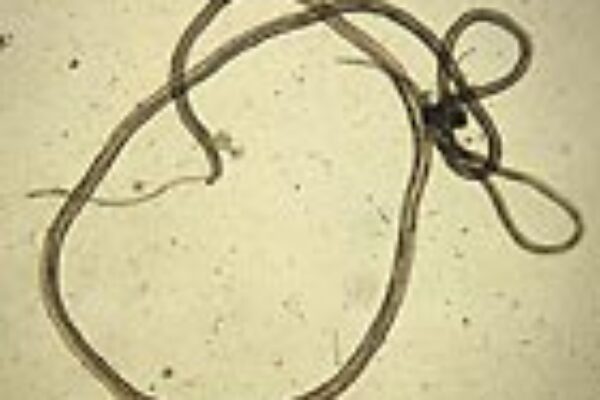

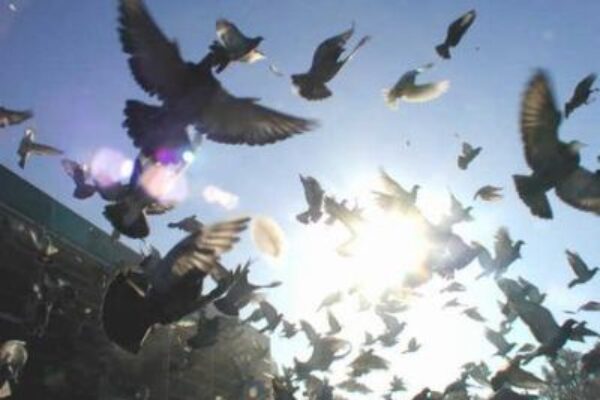



Well I was at my GP 2 months ago and he took a sample of my blood for testing. Good news came through that my cholesterol level is 0.07. I said to the GP: ” Look at me, fat belly, etc…” The GP said to me: ” That’s got nothing to do with your cholesterol level. That is body fat” Well now I am at a friend’s gym to work my body fat away. Further on the GP said: ” You are a healthy man.” At work I was told that I never been sick as long as work for the last 11 years. Straight after all that good news, I had the heavy flue and was off sick for 3 weeks. Bonkers isn’t it ? Well for the message above, I will take heed and obey to the full for me and my family. Thank you for the eye opener message.
very good article. I have suffered with this problem for years and have been treat with steroids twice to cure severe symptoms. The answer is to think dust every time you attend the birds. I have a light simple mask round my neck for simple POP IN loft tasks. Any mask is better than none at all. For more intense visits into the lofts then I use a more expensive Quality mask. People think that because they have a mask that has a visor and it blows air down their face it is good. Wrong,a good mask has to be top of the range KITEMARK standard, which means the air is filtered to a high degree before it is inhaled. Imagine a mask with no filter blowing air down your face then it would be no use whatsoever. The biggest problems I have encountered is the Face seal of masks.If they do not fit smug and tight to your face and nose contours the air leaks out and air is also inhaled in bypassing the mask. This is what causes steaming up of glasses. Another main way of having problems out of the lofts, is dust accumulating on your HAIR
Always wash your face,hands,AND hair when you have finished. A fanciers wife was diagnosed with Pigeon Lung and she never visited pigeons. Over weeks of tests, it was found to be coming off her Husband’s pillow and hair.
The mask I use along with cap and smock is a Sundstrom made in Norway. The main filter is P3 standard and takes 99.8% of dust out.The face seal is from neoprene and creates a flexible tight seal to the nose and face, and does not rot or mis shape. Of interest dust masks of this type have BEE’s wax impregnated in the filter material, and this helps to extract the dust. When I train with birds in my car, my baskets have the nest box type floor grills in the bottom on 3 layers of newspaper. I change the newspaper weekly. This keeps the birds clean and there is no litter to fly airborne all over. I do not open my car windows because this creates more dust. I play the air from the Dash board vents onto my face. Hope this helps, and always think Cap, Smock, Mask. and enjoy your birds.
Pigeon Allergy against Feather Protein is one thing and the next stage is Pigeon Lung the next stage. I am a pigeon scribe and the fellow scribe with the Rabbit hutch type loft was Keith Mott. I believe he has now gone onto a more normal loft,designed to keep the dust down.
Hi Barnsley,
Thanks for sharing your story and your procedures. Your comments will help many fanciers.
Thanks and good health!
-Chris
Do you have a reference for the hair as a vector?
thanks 4 all , can u tell me why my pigeons have desease in which they can use a single foot to walk and what are the remedies
Hi Your pigeons could have Paratyphoid or Samonella as it is more commonly called.
This causes stiffness in wings and legs,quite often the bird will have one or two wings dropped.
A few drops Cider vinegar in the water will help prevent further outbreaks.Also vermin, mice or rats can give your birds this disease as they urinate all over their food.
There is a drug called Baytril that can be used but it is very expensive.
I had an outbreak several years ago caused by vermin contaminated maize,the affected birds all had one dropped/stiff wing and some had stiff legs.Unfortunately even using drugs the birds still had severe stiffness in their joints, the only kind thing to do was put them to sleep.So keep all feed in vermin proof bins,do not overfeed your birds and have feed laying about in your loft.Use Cider Vinegar in the water.Destroy any contaminated feed.Cull affected birds that cannot walk or fly properly.Do not breed off affected birds for obvious reasons.
Hope this helps.
Yes all fanciers should wear a mask of some discription in the ltheir lofts, pigeon shows etc, yes I do wear a mask if I go to some fanciers lofts to clean especially if it takes more than a half an hour to a full day to clean sections.
If the lofts have wooden grills or perch trays or nest boxes definetly yes and when the pigeons are out flying it is better because of the bloom and inhaling the dust that they fly around you can esly cause some reaction to allergy to your health. Once or twice I cleaned out lofts to make a few bob, after cleaning even with a mask surgeon type Iafter a few hours later I still got flu like systems and feeling really terrible.
So I have to get a very good pigeon mask with clear visor ” as I wear glasses so they dont mist up on me ” and air going throug the mask to help me breath clearly and not
to inhale any sort of dust or particles in the air. Years ago I wrote pigeon articles around Dublin for the Irish fanciers for a UK magazine called Racing Pigeon Gazzett no longer published,I used to viist pigoen lofts on a reguler basis. But I never wore a mask fanciers think it is stupid but not now, I love viisting pigeon lofts to give me some ideas for better ventilation in my future and at least 80% dust free if we add either axtraction fans to our lofts or the old ways to open the front of the lofts.
Lofts have changed over the years,but they must be made for weather climates either hot or dampor winds blowing straight into the front of the lofts that is no good for the pigeons. I love building timber lofts and I have my own ideas on the loft structure and ventilation and to make it handy for the fanciers, I read about a pigeon fancier in the UK I cant remeber his name but he is a pigeon scribe who taught of an Idea why ?,
Because he had our biggest fears of pigeon lung and darent give up his passion for
his racing pigeons, so he made like rabbit hutches for pairs or bigger to house arms lenght to catch the pigeons with out going into a loft. He made a few pigeon hutches to house his pigeons and to catch them very easy and they came very tame. And as he had pigeon lung he cpild race and breed his pigeons with out wearing a mask only fresh air around him, I dont knoew how he got on with his pigeons racing wise, but certainly he could continue and nearly finished his love for his pigeons.
So wear a mask or make a pigeon hutche so it can work for your own injoyment, it makes sence and costs less more healtier for all, a pigeon will win a Open, National, Derby or maybe it has happened all ready.Keep healty and injoy our loved sport of Pigeon Racing.
Chopper.
Dublin, Ireland
Every pigeon fancier should wear a mask in the loft, even if there for a short time. I use a disposable one . Moldex 2700 N 95 . It is light and has an exhaust valve. When it gets dirty , just put a new one on . They are in black or white .
Dear this is very important for every one of us who have racing pigeon.
Thanks a lot for helping us.
Best regards
Ali Md. Sikender
wow, all i can say is , ill be more careful, my loft is very vented , ill wash out the inside more often, and be more precaurcious, everyone do the same , and lets keep having fun,
My father died from lung cancer,but I’m sure he had PFL as well because in his last couple of years with the birds he couldn’t be in the loft too long because he would start coughing,and gasping for air as if he had an alergic reaction to the birds or something.Thanks for the article.Something to take note of for sure.
thats a great article well appreciate having a girl that loves the birds and always crazy with the yb always puttin that bird name now to be on the rigth path thank you always,learn thanks again this one eye opener
This symptom is a real thing!! And the proof lies with the death of my dear friend at noon today. Just three weeks ago I spent 11 days with he and his son. There to hang out and enjoy the great weather of central Florida. I helped him alter his lotfs to allow for more air flow. His thinking was, that it would be the solution to his 18 month old cough. If we could only get more airflow through the lofts, he would be able to recover from what he knew to be the real cause of his cough/wheeze (the pigeon bloom/dust) and to be able keep racing pigeons. You see racing homing pigeons was his passion. As I’m sure are you reading this because you share his heartfelt passion for the “birds”. But the denial of this disease keeped him coming back to the lofts. Please pay attention to the onset of any deep chronic cough. And do not deny youself a long life.
Spring Hill Florida will miss you J.Keith Littlejohn as will we that love you back home in Kansas. Keith whent home to be with the Lord Jesus on February 14,2011